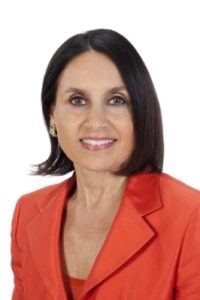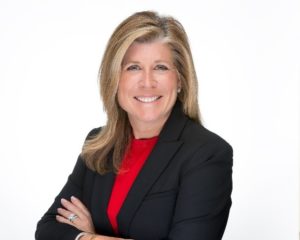

When Barbara Bufkin started in the insurance industry nearly four decades ago, she didn’t think about women’s roles. She started her career as a commercial underwriter, then a casualty facultative underwriter to a reinsurance intermediary. In fact, in the first five years of her career she had four job changes—unheard of at that time.
“When I transitioned over to the capital side of the business, I really didn’t know what a glass ceiling was,” said Bufkin. “When I confronted it, it had to be shattered; I didn’t think of it any other way.”
Today, many would say Bufkin has exceeded her goals. She is Chair of the International Board of Governors of the Insurance Industry Charitable Foundation (IICF), directly engaged in the global and national Women in Insurance Conference series, and President of the Association of Professional Insurance Women (APIW). Concurrently, she advocates for the value of the insurance industry as a career of choice in her role as Co-President and Board of Trustee of Gamma Iota Sigma (GIS) and as a keynote speaker on The Power of Purpose in various insurance industry forums. In these initiatives, she has been driving the Big Tent of culture, inclusion, innovation, sponsorship, mentoring talent and the power of networks.

“When I transitioned over to the capital side of the business, I really didn’t know what a glass ceiling was. When I confronted it, it had to be shattered; I didn’t think of it any other way.”
Barbara Bufkin
But this success didn’t come easy. Bufkin recognized that there were corporate barriers which she had to learn to navigate. Through that navigation she learned how to negotiate, a skill greatly needed in the business world. She had the courage to build the career she envisioned for herself by seeking out mentors whom she trusted.
Bufkin noted that there is a great need for women’s training. “We need to make sure that women’s voices are being heard when they are not in the room,” she said, adding that “we need to prepare women for executive roles. Giving women strong coaching to be more conscious of their own capabilities and confidence, to overcome ‘imposter syndrome’ and consider themselves for a position when they may not have felt ready for it.”
Bufkin said that the statistics and studies that are being conducted now are creating a true awareness around the importance of gender equality and pay equality. “There’s an intentional and committed focus around this,” she said.
There are also progressive companies like CSAA Insurance Group who engage in pay equity analysis to ensure equal pay between employees in similar roles. The objective is to determine that pay inequities are justified by compensable factors, like location and tenure, and not by unjustified factors, like gender or race and it has been a success at the firm.
It’s what drew Linda Goldstein to join CSAA Insurance Group and to work with Paula Downey, the first female president and CEO of CSAA Insurance Group.

“I hope more companies do an extensive pay equity analysis, the same way we did here, so they can finally close the pay gap.”
Linda Goldstein
“It provided a slightly different perspective than a public company led by mostly men,” she said.
Part of that different perspective was how women were compensated in the organization.
“I’m proud to say the gender pay gap is not an issue at our organization. I hope more companies do an extensive pay equity analysis, the same way we did here, so they can finally close the pay gap,” she said.
Goldstein acknowledged that women have been underrepresented in certain areas of the insurance industry. “There are different functions where you tend to see more men versus women, particularly in leadership roles,” she said, adding, “The insurance industry needs to do a better job of making sure woman are aware of the great opportunities across all of the functions. There is a plethora of jobs out there including innovation, actuary, underwriting, service, claims and marketing. But the insurance industry needs to promote those opportunities and support women who seek them out,” she said.
Women like Bufkin and Goldstein are encouraged that as people retire, women will be offered their share of opportunities.
“It’s important now to help build up the industry during a time of rapid replacement of talent,” said Bufkin. “For young woman who choose a career in insurance, it’s a great business to be in. It’s much more secure during cyclical changes and economic downturns.”
Challenges remain
While strides have been made—the number of Fortune 500 companies led by female CEOs has tripled in the last decade—they still account for less than five percent of the total group.
A 2018 report by McKinsey & Company, “Closing the Gap: Leadership Perspectives on Promoting Women in Financial Services,” surveyed 12 female executives and more than 14,000 employees at nearly 40 financial services companies. It found while women outnumber men at entry-level positions in the insurance industry, their representation of the workforce is significantly smaller near the top of the organizational chart. Women represent 56 percent of entry-level positions, but only 30 percent of the vice presidents and 18 percent of the C-suite.
And the situation is much more extreme for women of color in insurance. They hold only 12 percent of entry-level roles and a mere 3 percent of direct-reporting roles to the CEO. That means that black, Hispanic, and Asian women altogether make up only three percent of the insurance C-suite.
Yet studies have found that greater gender diversity can help organizations be more innovative and higher performing. A 2016 Credit Suisse report found that companies where women made up at least 15 percent of senior managers had more than 50 percent higher profitability than those where female representation was less than 10 percent. Moreover, of the 24 female CEOs in the S&P 500, 13 have led their companies’ stocks to outperform the index in terms of cumulative total returns during their tenures. Some have managed to produce triple- and even quadruple-digit percentage gains. Swiss Re Institute estimates that a 26 percent increase in global GDP in a scenario of labor market gender parity would yield an additional $2.1 trillion in global insurance premiums by 2029.
Women Still Lag Behind Men in Pay
According to PayScale.com women are often undervalued for the work they do, are more likely to hold lower-level, lower-paying jobs and they tend to stagnate in their careers, still making only $0.79 for every dollar made by men in 2019. Moreover, Hired.com’s State of Wage Inequality in the Workplacefound that companies pay women on average 4 percent to as much as 45 percent less than men in the same jobs—and these numbers haven’t changed since the company released its second annual 2017 report. In addition, 60 percent of the time, men are offered higher salaries than a woman, for the same role at the same company. he survey further reveals that of the 61 percent of women who discovered they were being paid less than men at the same role in their company, 16 percent found the difference was at least $20,000.
Women’s experiences in the workforce also vary vastly by race. PayScale.com noted that black and Hispanic women experience even wider pay gaps than white women, start their careers in lower-paying positions, and are less likely than white women to make it to the C-suite.
How the Industry is Working to Make a Difference
Insurers are making significant strides to improve gender diversity by creating sponsorship programs and addressing unconscious bias. There is, for example, the Bloomberg Gender-Equality Index, which tracks the financial performance of public companies committed to supporting gender equality through policy development, representation, and transparency. The 2020 Bloomberg Gender-Equality Index includes 325 companies across 50 industries, including insurance headquartered in 42 countries and regions.
There are organizations that are making a tremendous difference such as the, whichis dedicated to encourage women to embody the future of insurance through participation, progressive education, and engagement with forward thinking industry professionals. Then there’s the IICF and their Women in Insurance Conference Series, led by pioneer Elizabeth (Betsy) Myatt, vice president and chief program officer. There’s the Women’s Insurance Networking Group (WING) which helps increase awareness through events and are a platform to share skills and knowledge and finally the Women in Insurance Initiative (WWII), a consortium of organizations throughout the insurance industry which is taking substantive and measurable action by recruiting, mentoring, and sponsoring women to drive equality in career advancement and leadership throughout the insurance industry.
“We as women need to be fearless; to accept the challenges and sometimes to understand defeat,” said Bufkin. By doing so, can we stand back up and do it better, bigger, greater and stronger.”